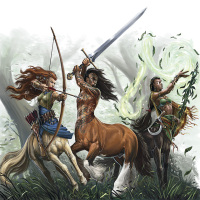
Centaur(s)
CBUB Wins: 1
CBUB Losses: 1
CBUB Ties: 0
Win Percentage: 50.00%
Added by: Mercenaryblade
Read more about Centaur(s) at: Wikipedia
Official Site: Public Domain
In Greek mythology, a centaur (from – Kéntauroi) or hippocentaur is a member of a composite race of creatures, part human and part horse. In early Attic and Boeotia vase-paintings (see ), they are depicted with the hindquarters of a horse attached to them; in later renderings centaurs are given the torso of a human joined at the waist to the horse's withers, where the horse's neck would be.
This half-human and half-animal composition has led many writers to treat them as liminal being, caught between the two natures, embodied in contrasted myths, both as the embodiment of untamed nature, as in their battle with the Lapith, or conversely as teachers, like Chiron.
The centaurs were usually said to have been born of Ixion and Nephele (the cloud made in the image of Hera). Another version, however, makes them children of a certain Centaurus, who mated with the Magnesia mares. This Centaurus was either himself the son of Ixion and Nephele (inserting an additional generation) or of Apollo and Stilbe, daughter of the river god Peneus. In the later version of the story his twin brother was Lapithus, ancestor of the Lapith, thus making the two warring peoples cousins.
Centaurs were said to have inhabited the region of Magnesia and Mount Pelion in Thessaly, the Foloi oak forest in Elis, and the Malean peninsula in southern Laconia.
No Fantasy Draft Records Available
